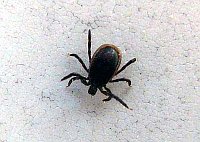Dangers of Ticks in the Czech Republic
European Blog on Tick Diseases
Quick Facts
- Hungary: Thanks to warm temperatures so far this year (2009), ticks have already started appearing in green areas, and 20-50 percent of them carries Lyme disease, while every thousandth is infected with encephalitis, reports hvg.hu. http://www.caboodle.hu/nc/news/news_archive/single_page/article/11/tick_invasio/?cHash=76be32b1ab
-------------------------------------------
The number of people in the Czech Republic infected by ticks is at its highest in a decade, according to figures just released by the State Health Institute.(2007)
- Over 350 people caught tick-borne encephalitis
- Nearly 2,300 got Lime disease between the start of January and the end of August 2007.
An elderly man died recently of tick-borne encephalitis, the first such fatality of 2008. However, number affected could rise soon, with evidence of infection often being felt in the autumn.
Resource
http://www.radio.cz/en/news/107951
----------------------------
Resource
http://www.radio.cz/en/article/88123
-------------------------------------------
TICK-BORNE ENCEPHALITIS - AUSTRIA
********************************************
Experts of the International Scientific Working Group on Tick-Borne Encephalitis (ISW-TBE) have been warning of the dangers of tick-borne encephalitis (TBE). Now, hikers are among those in danger, because tick [numbers] have been climbing higher.
The year 2008 marked the 1st time that ticks infected with the TBE virus were detected at more than 1500 meters above sea level, one of the consequences of global warming. The ISW-TBE has been calling for vaccination against TBE to become a standard preventive measure for everybody traveling to endemic regions.
For travelers, failing to undergo preventive vaccination may have far-reaching consequences. TBE, a viral disease transmitted by ticks, affects the central nervous system. Its diverse forms of expression range from minor neurological dysfunction to impaired concentration,depression, severe paralysis, or even death.
"Since 1990, more than 157 500 cases of TBE have been registered in Europe, corresponding to 8755 cases annually. Its climatic conditions make Austria a high-risk country for TBE. Because vaccination coverage in Austria is exceptionally high, the number of TBE cases has come down from 677 in 1979 to 86 in 2008," explains Professor Jochen Suss, Friedrich-Loffler-Institute, Jena. "At a European level," says Professor Pier Luigi Lopalco from the European Centre for Disease Prevention and Control (ECDC), "TBE is not yet a notifiable disease. However, we have been working to raise awareness of the dangers of TBE to motivate people to get vaccinated." Once infected, there is no [specific] treatment available.
Resource
http://www.bada-uk.org/wordpress/?cat=10
----------------------------------
A record number of people, over 3900 were infected by ticks in the Czech Republic in the first half of 2008, which is the highest figure for the same period since 1982 when the data started to be registered, the State Health Institute (SZU) informed CTK today.
A total of 238 people got ill with tick-borne encephalitis and 1663 with Lyme disease (borreliosis) between January and June in the ten-million Czech Republic.
The incidence of tick-borne encephalitis has been the highest since 1982, according to the SZU data.
In 1982, 51 case were registered.
The number of people infected with Lyme disease has also been rising, though not distinctively, Dagmar Hulinska, from the SZU, said.
The institute has annually registered some 3000 cases for a couple of years.
Experts point put that the higher amount of infected ticks is connected with changes in the wild, in particular milder winters and longer summers.
Hulinska added that ticks now appear in higher altitudes more often than in the past.
Health Ministry spokesman Tomas Cikrt said the number of people infected by ticks would be rising year-on-year in the Czech Republic.
The ministry therefore recommends that people be vaccinated against tick-borne encephalitis.
The increased incidence of infected ticks has been reported on over 90 percent of Czech territory.
The highest number of tick-transmitted illnesses is annually registered in south Bohemia, the Vysocina Highlands and in the surroundings of the Vranov dam and Brno, south Moravia.
In 2007, 542 people got tick tick-borne encephalitis and four of them died, and 3559 people suffered from Lyme disease in the Czech Republic.
Unlike tick-born encephalitis, there is no vaccination available against Lyme disease. However, pharmaceutical companies are developing a vaccine.
A Czech company has recently started testing a new vaccine against borreliosis.
Tick-transmitted illnesses in CzechRep from January to June
Jan- June 2000 2001 2002 2003 2004 2005 2006 2007 2008
Lyme disease 1114 1297 1546 1292 1216 1166 1255 1494 1663
tick-borne encephalitis 141 139 185 209 119 137 184 205 238
Total 3255 3437 3733 3504 3339 3308 3445 3706 3909
Resources
http://www.praguemonitor.com/en/395/czech_national_news/26471/
Source: State Health Institute (SZU)
http://www.praguemonitor.com/en/395/czech_national_news/26471/
